Jewellery and History entwined, tenuously and/or otherwise... Longer-form explorations and musings brought to you by Hannah.
Don't wanna be here? Send us removal request.
Text
Roman "Asclepius & Hygeia" Carnelian Intaglio Signet Ring

A fascinating antique signet ring with an ancient Roman intaglio. The carnelian agate intaglio depicts two Greek gods- Asclepius, the god of medicine and Hygeia, his daughter and goddess of health. Asclepius carries a snake-entwined staff, while facing his daughter. The ring mount is crafted in solid 18 karat yellow gold.


Asclepius was the son of Apollo and mortal princess Coronis. His name- literally meaning "to cut open" as he was born by caesarean section. He was married to Epione, the goddess of pain relief and healing. Her name comes from the Greek word "epios", which means "soothing". They together had a number of children, including Hygiea. Asclepius was given to the Centaur Chiron, the wisest of all centaurs, who raised him and taught him medicine and the healing arts. Legend has it, at some point along the way, Asclepius healed a snake, which in return taught him secret knowledge... Snakes were considered divine beings that were wise and could heal and this is how his symbol came along.
Hygeia's (hygiene) classical symbol was a bowl containing a medicinal potion with the serpent of wisdom consuming it. This is the same serpent of wisdom, which appears on the staff of Aesculapius. She played an important part in her father's cult, while her father was more directly associated with healing, she was associated with the prevention of sickness and the continuation of good health.

#antique jewelry#butter lane antiques#fine jewelry#antiques#antiquejewelry#butterlaneantiques#mythology jewelry#greek mythology jewelry#greek mythology#greek god#roman jewellery#roman jewelry#roman#fresco#hygeia
10 notes
·
View notes
Text
Victorian "Man in the Moon" Saphiret Ring

This fantastic Victorian ring is set with the most unusual saphiret , perfectly moulded to create the man in the moon. Saphiret is a rare type of glass that was produced during the mid 19th century in the town of Gablonz, Czechoslovakia. It's distinctive and shimmering colour is produced by fusing karat gold with a sapphire coloured glass, creating a beautiful outcome much like this piece. It rests within a closed backed setting, with a slim band, crafted in 15k gold throughout. A gorgeous piece, they don't come up often...



#antique jewelry#butter lane antiques#fine jewelry#antiques#antiquejewelry#butterlaneantiques#man in the moon#victorian era#victorian ring#victorian style#victorian history#fashion history#Saphiret#Saphiret jewelry#Saphiret gemstone#antique rings
6 notes
·
View notes
Text
Art Nouveau French 18k Gold & Diamond "Chimera" Ring

In Greek Mythology, Chimera was a monstrous fire-breathing hybrid creature. It has the body and head of a lion, a goat's head rising from its back, the udders of a goat, and a serpent for a tail. It was the terrifying offspring of Typhoeus and Echidna.
Typhoeus, known as the father of all monsters and was depicted as half man half snake. His top half was "human" like but he had two coiled serpents in place of legs. He could breathe fire and he attempted to overthrow Zeus for the supremacy of the cosmos- to put a long story short, Zeus won. Echidna was a monstrous she-dragon with the head of a woman and the tail of a coiling serpent. She embodied the terrifying and the unknown and passed this onto her offspring.
Greek hero, Bellerophon set out to slay Chimera, and on his way to find the best, he meets a seer who tells him he’ll need the winged-horse Pegasus on his journey. As he approaches Chimera, he attaches a block of lead to the tip of his spear and uses it as a shield, until charges at Chimera and jams the lead block down the beast’s throat.

This At Nouveau French made ring depicts the beast Chimera, it's whole body creating the band of the ring. The head depicts the beasts head, "protecting" a diamond below it's foot. It's crafted in 18k yellow gold throughout, and features French marks.
#antique jewelry#butter lane antiques#fine jewelry#antiques#antiquejewelry#antique diamonds#butterlaneantiques#art nouveau#art nouveau jewelry#greek mythology#greek mythology jewelry#greek myth art#art nouveau ring#art nouveau style#chimera#monster art#monster#mythology jewelry#classical mythology#ancient greece#gods#greek gods
2 notes
·
View notes
Text
Antique French Quimper Porcelain & Enamel Rivière Necklace


Quimper, pronounced “cam-pair” has been manufactured in Quimper, a town in Brittany, France for over 300 years. Created in 1690 at the time of the royal manufactures, they specialised in earthenware- tableware, interior decoration and also a line of elegant jewellery. Earthenware is glazed or unglazed pottery that has normally been fired below 1,200 degrees. Earlier stoneware was carefully marked because of government regulations, however for the most part Quimper pottery was not systematically marked until around 1870.

This amazing piece dates to around 1780. The rivière style necklace is made up of hearts, with lovely enamel portraits. As you go along each portrait, a small story is told, well matched with the hearts. They're set in place with claw settings, linked together by two fine chains and it fastens with a hook and eye type clasp. It has a wearable length of 16 inches and remains in incredible condition considering it's age
#antique jewelry#butter lane antiques#fine jewelry#antiquejewelry#georgian era#georgian jewelry#quimper#quimper jewelry#french antiques#french antique jewelry#quimper pottery#quimper earthenare#georgian style#1800s#1700s#1700s jewelry#french jewelry#french antique
11 notes
·
View notes
Text
The World's Most Famous Diamonds

This remarkable collectors set is definitely the best curiosity we've had here at Butter Lane in a long time. The set consists of 15 replicas (cut to size) of the worlds most notable diamonds, made from crystal, with a perfectly fitted box and diamond booklet. In the set we have, The Shah (89ct), Pasha of Egypt (40ct), Orloff (200ct), Piggot (49ct), Polar Star (40ct), Sancy (55ct), Florentine (137ct), Grand Mogul (280ct), Kohinoor Old Cut (186ct), Nassak (81ct), Blue Diamond - Hope (45ct), Kohinoor New Cut (109ct), Jubilee (245ct), Regent (141ct) and finally the South Star (129ct).
One of my favourites, the Sancy Diamond, a fiery stone of Indian Origin. It's pear shaped, pale yellow in colour and weighs 55 carats! -Just about the size of a strawberry. This stone has been passed through many royal families, pawned and even stolen. My favourite (but gruesome) story about this stone dates back to King James I in 1605 when he bought the stone from Henri IV of France and his minister of finance, Seigneur Sancy. He became broke due to his highly expensive and fancy lifestyle, and the servant delivering the stone to King James was held up by thieves, in which he swallowed the stone. I must say, it must have been hard to swallow. However, the loyal servant was killed anyway and the stone was removed from his body (yuck).
Another stone, the Pasha of Egypt. It's considered the finest gem of Egyptian treasury, weighing in at 40 carats!! It's of octagonal shape and is of amazing cut, quality and colour. The whereabouts of this beautiful gem is unknown, rumour suggests it was purchased for over 28k by Ibrahim Pasha (1789-1848), viceroy of Egypt under Ottoman ruling. Fast forward to 1933, an Englishman put this stone up for sale and it eventually made it's way back to Egypt in possession of King Farouk. The worldwide known jewellers BVLGARI bought it off him and sold it to the "Poor Little Rich Girl" aka Barbara Hutton, in which she had the stone cut and set into a ring. The stone now weighs 36.22 carats and is privately owned in Europe.


The Shah diamond. Often described as the shape of a coffin, the cut of this stone is technically called a lasque cut; typical of Indian diamonds and it weighs in at a great 89 carats!! It takes it's name from the Nizam Shahi, a dynasty of rulers from the kingdom of Ahmadnagar, who ruled the state of Deccan in the middle-west part of India between 1490 and 1633. This rare stone would bear three inscriptions:
“Burhan Nizam Shah II in the year 1000” – about 1591
“Son of Jahangir, Shah Jahan, 1051” – about 1641
“Kadjar Fath Ali Shah” – Shah of Persia in 1824.
Since nothing will cut a diamond, but a diamond, some sort of diamond carving tool must have been used to engrave it, and the first inscription is the name of the ruler of Ahmadnagar. The second tells us that the stone was held by the Mogul Emperor Shah Jahan, grandson of Akbar, in 1641 And finally the third shows it was looted (along with the along with the Koh-i-Noor) by Nadir Shah, and was taken to Persia when his armies ransacked Delhi in 1739.
The Shah diamond’s next destination came about because of the assassination of the Russian diplomat, Alexander Griboyedov. He had a powerful influence among the rulers of Russia and played a role in the defeat of Shah Abbas Mizra (1789-1833), the viceroy of Azerbayjan. Griboyedov successfully negotiated the treaty of Turkmanchai with Persia, gaining valuable Russian territory, after their 1827 dispute.
Griboyedov was appointed the Minister of Persia and he soon returned to Tehran, even with his unpopularity in Persia. He was then killed by an angry mob who stormed the Russian legation on January 30, 1829 and the 89ct Shah Diamond was sent to Russia as an apology and as a gesture of appeasement to Czar Nicholas I. The gesture was successful and further warfare was stopped.
The Shah was made a part of the Russian crown jewels until the Bolshevik revolution of 1917. It disappeared for a short time and was rediscovered in 1922. The stone was then placed on display at the Russian Diamond Fund in the Kremlin, Moscow as one of the “Seven Historical Gems,” where it remains to this day.

#antique jewelry#butter lane antiques#antiquejewelry#fine jewelry#diamond history#diamonds#famous diamonds#world diamonds#shah diamond#sancy diamond#indian diamond#antique diamonds#famous jewellery#famous jewelry
1 note
·
View note
Text
proposes to you with this ancient egyptian faience ring of a cat with kittens

4K notes
·
View notes
Text
The Beautiful and Rare: The Burma Ruby
Burma, also known as Myanmar, has been the source of some of the world's finest rubies for centuries. Burmese rubies are famed for their strong and vibrant colour, making them the most desired of all!
Every mine produces a wide range of quality. The fact that a ruby comes from a famous mine doesn’t mean it is good quality... But fine-quality rubies that have Myanmar (Burmese) origin definitely are.

This for example: Edwardian Burma Ruby Cabochon & Diamond Cluster Ring
This beautiful oval shaped Burma ruby cabochon takes centre stage of this amazing cluster ring. The ruby weighs 3.3 carats and looks amazing in both daylight and iridescent light, with a rich and intense colour. The stone is complemented by a cluster of sparkly old cut diamonds, set in a way that creates great movement and placing the ruby to centre stage.


#antique jewelry#butter lane antiques#fine jewelry#antiques#antiquejewelry#edwardian jewelry#burma ruby#ruby jewelry#ruby rings#burmese ruby#burma ruby ring#burma ruby jewelry#mined ruby#ruby engagement ring#edwardian fashion
6 notes
·
View notes
Text
Snakes: A Victorian Symbol

The snake/serpent is a timeless symbol... and is seen in many beautiful pieces of antique jewellery from the ancient to the modern.
Historically, the serpent has been a great symbol of fertility and, through the shedding of their skin, represent re-birth, immortality, and healing.
During the early years of Queen Victoria's reign, a courtship started with her future husband Prince Albert. He gifted her a snake ring with emerald set eyes, which then became incredibly fashionable! Lets say Queen Victoria was a bit of a trend-setter.


This fantastic antique snake ring dates from the Victorian period, circa 1899. The ring band is formed from the snake's body, while the tail loops around the head. The snakes head is set with a pear shaped emerald "brain", while the eyes are set with little rose cut diamonds. Black crosshatched enamel spreads across the tail and head, with small enamel eyelid and mouth details. It's crafted in 15k gold throughout with the year 1899 engraved on the inside of the band. It's a lovely example of the well known "snake ring", and remains in great condition.
#antique jewelry#butter lane antiques#victorian jewelry#victorian era#antiques#snake ring#snake jewelry#emerald ring
9 notes
·
View notes
Text
High Victorian Diamond & Blue Enamel Convertible Bracelet

This exceptionally high quality and beautifully made high Victorian boxed bracelet is set with gorgeous blue enamel and chunky old and rose cut diamonds. It's crafted in 15k yellow gold with silver settings, and the main event, a large flower cluster- each petal set with a bright and sparkly old mine cut diamonds. The centre diamond weighs in 1.74 carats, and the petals a 3.4 carat total. The cluster is detachable, and brooch fittings can be found in a little compartment within the box. The chain style bracelet is covered in a rich blue enamel, with old and rose cut diamond accents (0.78 carats) in foliate motifs. It fastens with a double hinged clasp and is made to fit a 6.1 inch wrist. A breath-taking piece for sure, and it dates to circa 1860.




#antique jewelry#butter lane antiques#fine jewelry#antiques#antiquejewelry#butterlaneantiques#victorian jewelry#victorian style#victorian era#victorian history#antique bangle#antique bracelet#antique diamond#antique diamonds#victorian diamond
6 notes
·
View notes
Text
Arts & Crafts Multi-Gem Brooch Attributed to Dorrie Nossiter
An exciting multi-gem antique brooch, attributed to the jewellery designer Dorrie Nossiter. She was an Arts and Crafts jewellery maker/designer known for her nature inspired jewellery. She was born in 1893 in Birmingham and attended the Municipal School of Art from 1910-1914. She studied drawing with a focus on drawing plant form and after this she and her family moved to Dorset where she was inspired by the colours and shapes in her garden. Nossiter then moved to London where she created most of her work.
This brooch is crafted in silver with small gold pommels, set with an array of colourful gemstones. The main event, a large 23.8 carat amethyst displaying an intense pink/purple with an open backed setting allowing the light to shine through the stone enhancing it's vibrancy. Surrounding the stone, a cluster of citrine, baby blue zircon and tourmaline. The colour combination of the stone are gorgeous, and it dates from the Art's & Crafts period. A fabulous attribution to Dorrie Nossiter herself.

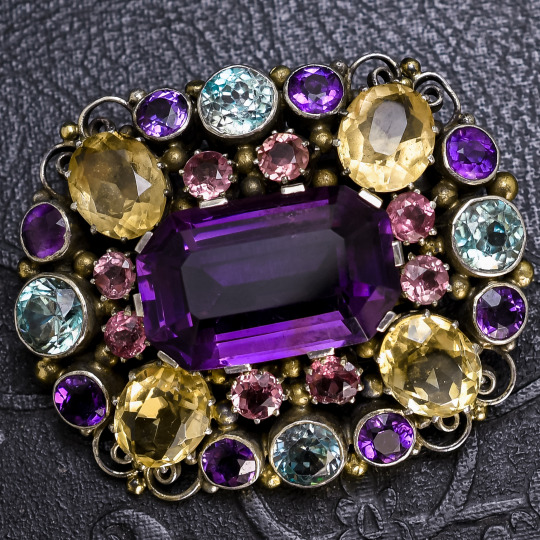
#antiquejewelry#butterlaneantiques#antique jewelry#fine jewelry#antiques#butter lane antiques#vintage#arts and cra#arts and crafts#brooches#brooches are back#brooch#art nouv#art nouveau jewelry
3 notes
·
View notes
Text
Art Deco Jean Painlevé Bakelite Seahorse Bangle
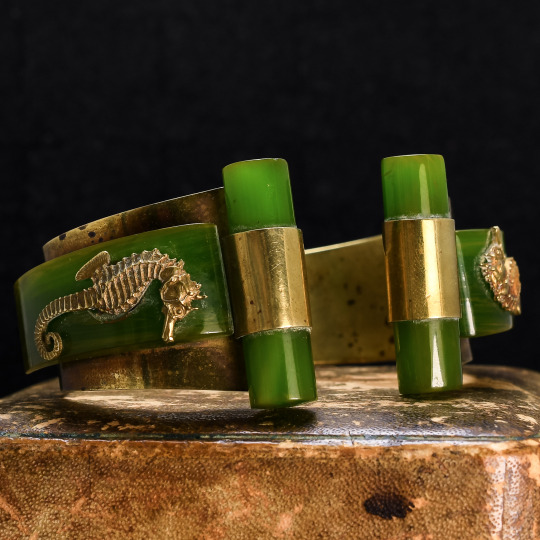
An especially cool Jean Painlevé bangle dating from the Art Deco period, circa 1935. Jean Painlevé, a French film maker with an interest in biology. Painlevé’s breakthrough came in 1935, with his film "L’Hippocampe" or The Seahorse. In the wave of his success, in 1936, Painlevé and his wife commissioned a range of seahorse jewellery. This piece, a yellow metal torque bangle, topped with bakelite and two gold coloured seahorses. It's not your typical shaped bangle, but is more oval shaped, with two "cylinders" of bakelite to slip your wrist through.

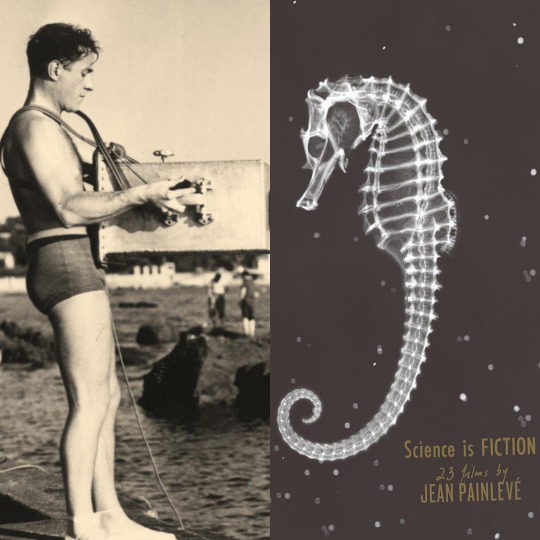
#antiquejewelry#antique jewelry#butterlaneantiques#fine jewelry#antiques#butter lane antiques#art deco#art deco jewelry#art deco style#art deco fashion#jean pain#jean painlevé#the seahorse
0 notes
Text
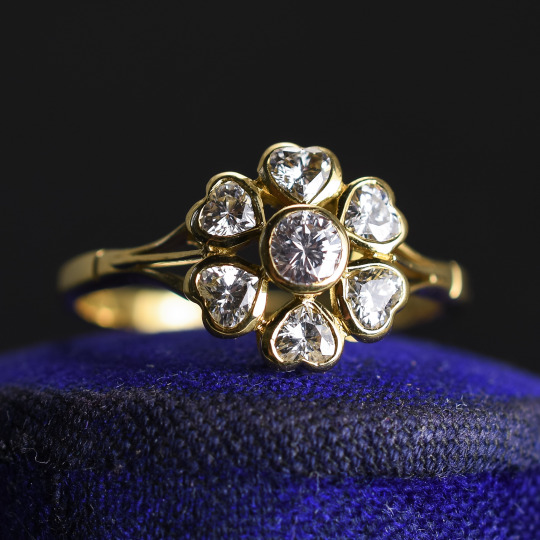
Hearts and diamonds are a match made in romantic heaven..
This charming Vintage cluster ring features gorgeous heart shaped diamonds and a brilliant cut diamond, arranged in a lovely flower cluster formation. It's crafted in 18k gold throughout with lovely split shoulders, and features English hallmarks dating it to 1987.
The lineage of the heart-shaped diamond stretches back over half a millennium! Its inaugural mention is attributed to Francesco Sforza, the Duke of Milan, in 1463, during an intriguing conversation. In this exchange, the Duke analogized the legendary exploits of the affluent "Cosimo de Medici" from the political dynasty in Florence to the allure of a heart-shaped diamond. If we entertain the veracity of this dialogue, it suggests that heart-shaped diamonds were fashioned prior to the 15th century and gained renown as emblems of regal status.
Following closely, in 1562, Mary Queen of Scots gifted to Queen Elizabeth a magnificent ring embellished with a heart-shaped diamond. This illustrious gem ranks among the most celebrated diamond hearts in history, imbued with connotations of camaraderie and benevolence during its era.
#antiquejewellery#antiquejewelry#antiquerings#antiqueclusterring#antiqueflowerring#antiquediamondring#antiquediamond#antiqueringsoftheday#ringsoftheday#ringsofinstagram#showmeyourrings#vintagejewelry#vintagejewellery#vintagerings#vintagestyle#vintagediamonds#vintagejewels#vintage#heartcutdiamonds#heartdiamonds#heartdiamondring#heartcutdiamondring#butterlaneantiques
7 notes
·
View notes
Text
19th Century Scottish "Pebble" Jewellery
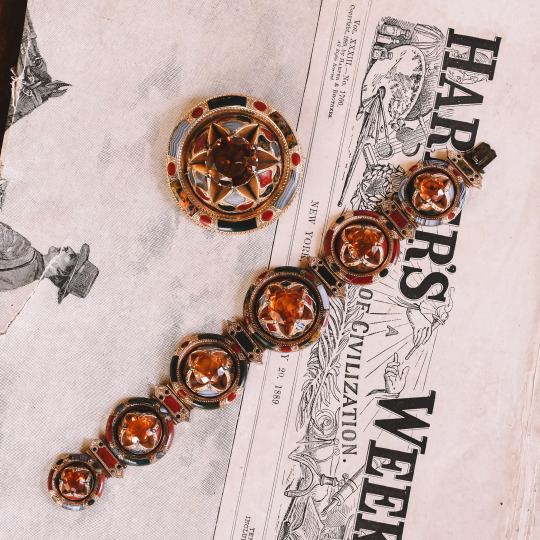
Scotland is known for its abundance of coloured agate which is found in a huge variety of colours and patterns, each type specific to a particular locality. Lapiadaries working in Edinburgh's "new town" made most of the pebble jewellery produced in the 18th and 19th centuries, sourcing stones from collectors who scoured the country in search of new deposits. Queen Victoria's love for all things Scottish generated a buoyant demand for jewellery of this style, and it's estimated that the number of people working in jewellery manufacturing in the 1870s exceeded two thousand.


A superb antique pebble bracelet and brooch set made in Scotland in the latter half of the 19th century. It comprises a series of graduated discs, each one featuring a Cairngorm citrine that forms the top of a dome with triangular cut-out sections to create a star motif around it. The gold is finely engraved with abstract foliate detailing, and inlayed with colourful varieties of agate and hardstone, including jasper, Montrose agate, granite, and bloodstone.
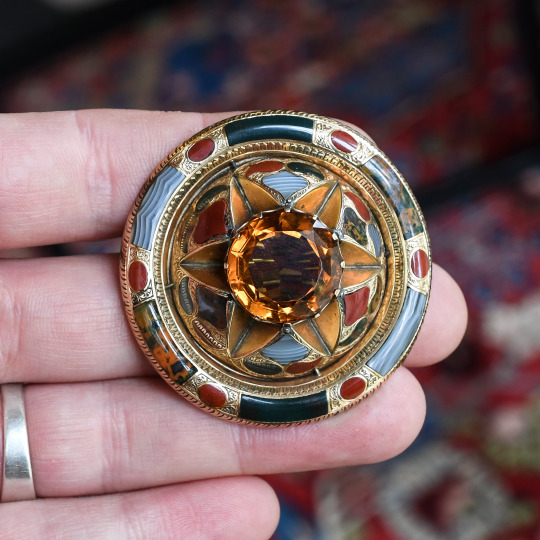
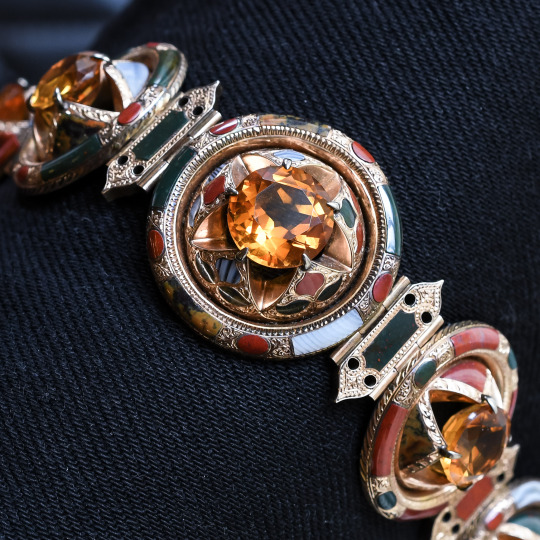
Further reading: Agates of Scotland
4 notes
·
View notes
Text

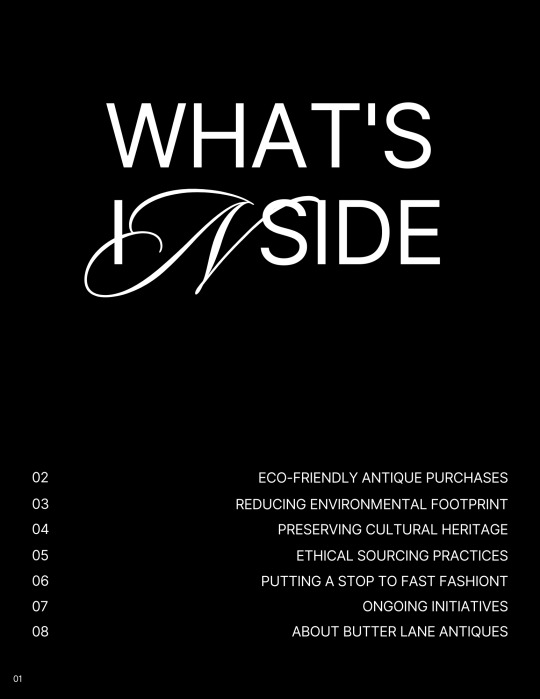



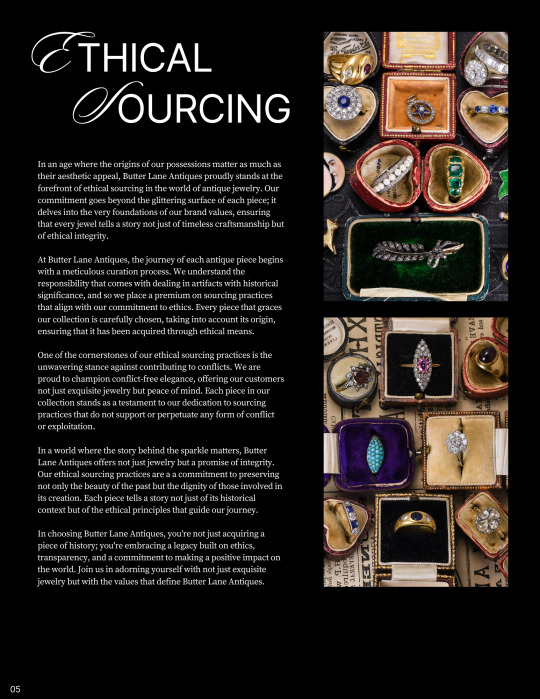
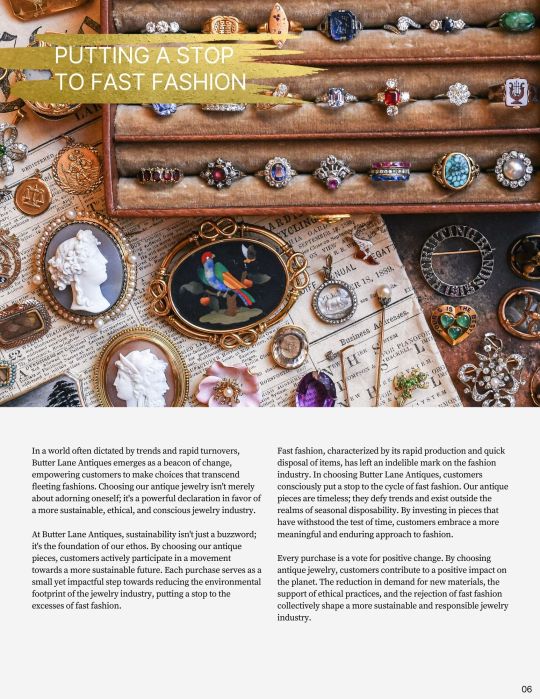

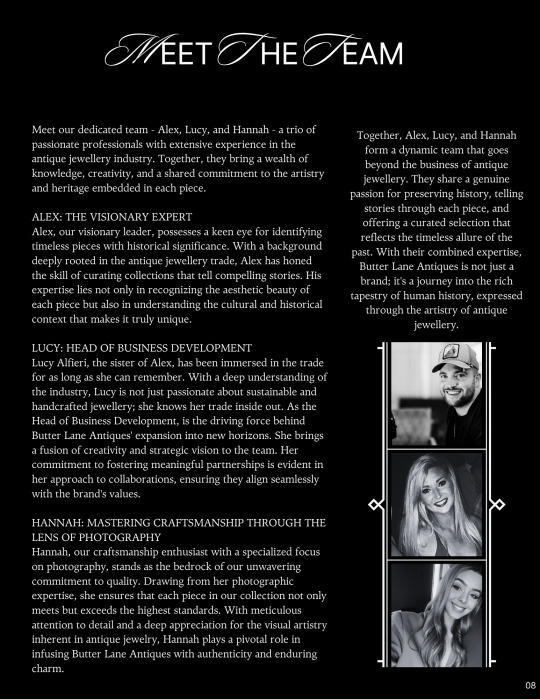

Adorning With Purpose - A Guide to Sustainable Jewellery
#SustainableJewelry#EthicalFashion#SlowFashion#GreenLiving#EcoFriendlyJewelry#EthicalSourcing#ArtisanCraftsmanship#RecycledMaterials#ConsciousConsumption#JewelryForChange#SustainableStyle#GreenFashion#EcoLuxury#ResponsibleProduction#ReduceReuseRecycle#EnvironmentalAwareness#EthicalDesign#JewelryWithPurpose#SustainableLiving#FashionRevolution#FairTradeJewelry
3 notes
·
View notes
Text

A Journey Through the Ages
In a world of fleeting trends, antique jewelry stands as a testament to enduring elegance. Join us on a journey through history, appreciating the craftsmanship that narrates tales of bygone eras.
Pre-Georgian (Pre 1714): Jewelry has been a constant companion throughout history. From Ancient to Medieval times, precious gemstones adorned people, occasionally preserved underground for centuries. This period encompasses the grandeur of the Baroque style.
Georgian (1714 - 1830): Spanning from the early 18th to the early 19th century, the Georgian era exudes grace and sentimentality amid social and political upheavals. Reserved for the aristocratic elite, Georgian jewelry features opulent gemstones like garnets, emeralds, and diamonds, with intricate metalwork and nature-inspired motifs capturing the essence of a romantic age.
Victorian (1837 - 1901): The Victorian era, under Queen Victoria's reign, witnessed stability and prosperity. Departing from Georgian rationalism, Victorian jewelry embraced romantic ideologies, symbolizing everything from Hope to Death. As the middle class grew, increased disposable income and advanced production techniques made jewelry accessible to the masses.
Art Nouveau (1890 - 1915): Reacting against Victorian industrialism, Art Nouveau, or "New Art," flourished from 1890 to 1920. Characterized by flowing curves and nature-inspired motifs, this movement brought a departure from large diamond pieces, focusing on vitreous enameling and unconventional gemstones. It aimed to distance itself from Victorian industrialism, making jewelry more accessible.
Edwardian Grace (1901 - 1910): The Edwardian period, from King Edward VII's reign to 1920, radiates leisure and elegance. Departing from High Victorian ostentation, late 19th-century jewelry trends embraced smaller, more refined pieces. Technological advancements, especially in platinum usage, allowed intricate metalwork, defining the delicate elegance of the Edwardian era.
Art Deco (1920 - 1935): Emerging before World War I, Art Deco blended modernist aesthetics with meticulous craftsmanship. Influenced by Cubism's geometric forms and the vibrant colors of the Ballet Russes, it broke down barriers between artists and craftsmen. Designers like Cartier and René Lalique shifted focus to colorful gemstones, employing millegrain and embracing futuristic geometric designs.
This journey through time illustrates the evolution of jewelry, where each era tells a unique story of societal changes, evolving aesthetics, and exquisite craftsmanship.
1 note
·
View note
Text
MEDUSA
Medusa is the best known of the three monstrous Gorgon sisters. Our earliest reference to the Gorgons is found in Hesiod's Theogony, but it was Ovid who really fleshed out the story - in the Metamorphoses - where he describes Medusa in her youth: "Medusa once had charms; to gain her love A rival crowd of envious lovers strove. They, who have seen her, own, they ne'er did trace More moving features in a sweeter face. Yet above all, her length of hair, they own, In golden ringlets wav'd, and graceful shone." Her beauty caught the eye of Poseidon, who forced himself upon her in a shrine to Athena. Athena was furious; she turned Medusa's hair into snakes, and made her face so hideous that anyone who saw it was instantly turned to stone (literally petrified). In most versions of the story, Medusa was killed by Perseus who was given various items to help him on his quest: a mirrored shield from Athena, a sword forged by Hephaestus, and Hades's helm of invisibility. While looking at the reflection in the shield, Perseus was able to behead the Gorgon, at which point Pegasus flew out of her severed neck. He went on to use her head - which retained its petrifying effect - as a weapon, using it to transform the Titan Atlas into stone (where he still stands in North Africa as the Atlas Mountains), before eventually giving it to Athena. Although Medusa is commonly regarded as a monster, her head has often been seen as a protective amulet to keep evil away. Indeed, the name Medusa comes from the ancient Greek word meaning "to guard or protect".
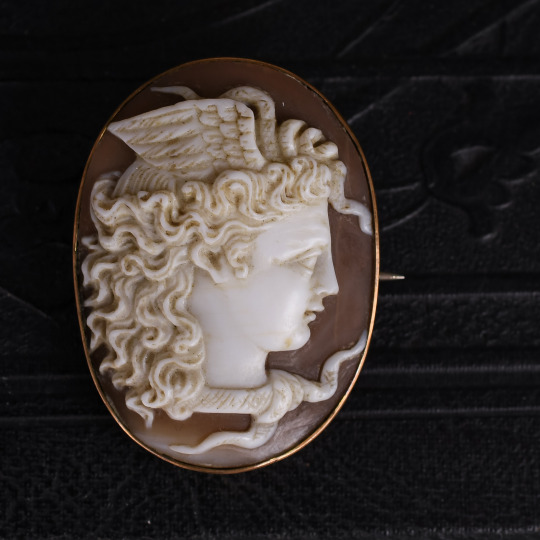
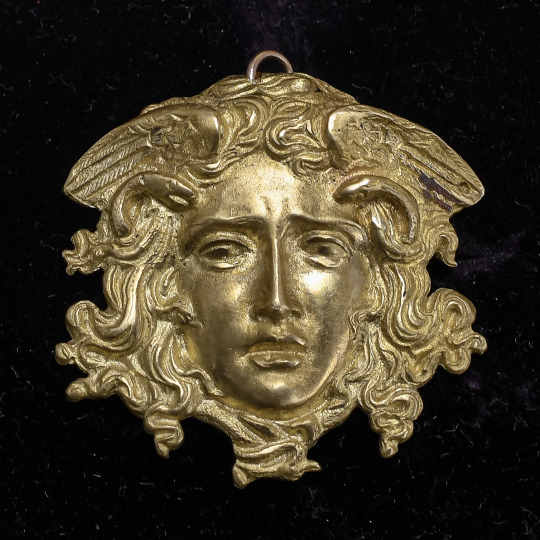
#medusa jewelry#antique jewelry#medusa head#mythology#mythology jewelry#antique brooch#brooches are back#butter lane antiques
11 notes
·
View notes
Text
LAPIS LAZULI

For centuries, Afghanistan has been an important source for top-quality lapis. Historians beleive the link between humans and lapis lazuli stretches back more than 6,500 years. The gem was treasured by the ancient civilizations of Mesopotamia, Egypt, China, Greece, and Rome.
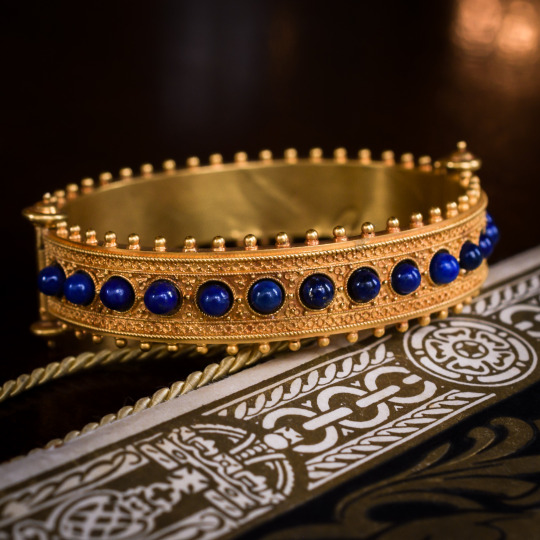

Lapis lazuli is a powerful stone for thinking and spirituality, and it has a very high vibration. It’s believed to increase self-knowledge and awareness of one’s own thoughts and can help you to trust your inner wisdom.
17 notes
·
View notes